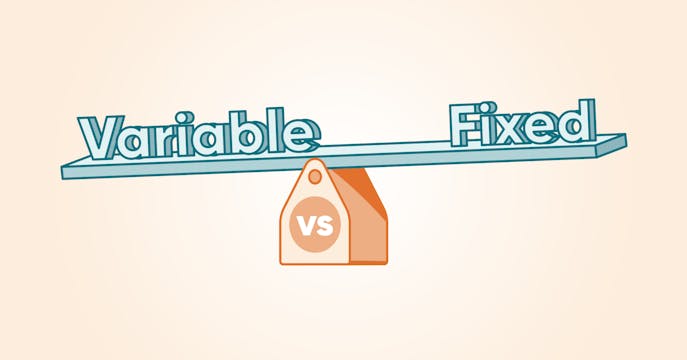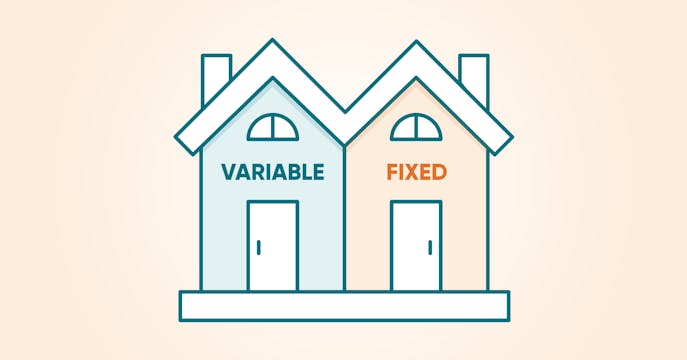Variable mortgage rates are finally dropping.
So why aren’t they more popular?
Despite potential savings in sight, most homeowners are still avoiding this rate type. Here’s why.
To be in a variable-rate mortgage, or not to be?
That’s the existential (mortgage) question for Canadians considering their best rate move for their first or next term.
So far, the answer is mostly ‘thanks but no thanks,’ despite the real potential for a 5-year variable mortgage rate (that floats with changes to bank prime rates) to go lower during its term than any fixed mortgage rate locked into today.
Let's take a closer look.
(Mortgage) money talks.
Dan Eisner, founder and CEO of True North Mortgage, explains why he feels more clients aren't opting for a declining variable rate.
"Homeowners tend to look at the mortgage math for the immediate impact on their monthly budget," remarks Dan. "With most fixed rates offering a much lower mortgage payment than a still-higher variable, those are winning the day versus trying to predict where variable rates will go."
Dan reports that only about 14% of their mortgage clients in 2024 have chosen variable rates so far, compared to about 68% taking 3- or 5-year fixed rates. Back in November 2023, when prime rate drops were thought to be imminent, about 37% chose variable.
Once bitten, twice shy.
It's not just the reluctance to disregard the fresh 'mortgage' memory of enduring several variable rate hikes over the past couple of years; it's also that the rate drops took much longer to start than anticipated, with the first cut not arriving until June 2024.
"By this June," Dan says, "even the diehard variable fans were starting to choose fixed rates and shorter-term options, such as our fixed 6-month Rate Relief product or our 2- or 3-year deals, to wait a bit longer on what interest rates might do."
In addition to this variable rate 'aversion'? Fixed rates are currently lower, making any future variable savings perhaps not quite tempting enough.
How much could a variable rate save you?
With the recent Bank of Canada policy rate cut, variable rates went lower but are still higher than True North's best 5-year fixed rate deal of 4.34%.
Using a mortgage of $500K with a 25-year amortization as an example — let's say you choose a variable-rate mortgage that offers 5.25% (after the lender's discount off prime), and the prime rate drops another 1.25% in total a year or so into your 5-year term. Compared to locking in with a 5-year fixed rate of 4.34%, the savings could come to at least $2,500.
That $2,500 is money that can be spent elsewhere rather than on your mortgage. However, these potential savings may not be enough to sway you or other homeowners from the relative safety of fixed rates and payments.
If the prime rate drops even further than this prediction? That's a perk of the variable rate risk — you'd save even more.

Will clients remain wary of variable rates?
Despite the anticipation of prime rate drops, a variable-rate mortgage hasn't been a popular choice so far in 2024, with more favouring the popular 5-year fixed rate.
(Based on all lenders we placed clients with, including our in-house, CMHC-approved THINK Financial.)
The 3-year fixed rate has also remained popular this year — about 33% of our clients chose this rate in July 2024.
Note: During 'normal' times, about 60% of clients usually choose a 5-year fixed rate vs. about 30% for variable; a 3-year rate might typically be selected by roughly 7% of clients.
Does a variable rate come with other benefits?
A variable-rate mortgage offers other advantages, like the flexibility to lock into a fixed rate at any time, penalty-free.
And you'll pay a lot less in penalties than a fixed rate if you switch lenders for a better rate or product or because you need to move. (Fixed-rate mortgages incur IRD charges, which can cost thousands more than the 3-month interest penalty of a variable rate.)
Think you won't need (or want) to break your 5-year fixed mortgage? It happens more often than you think; this term length averages about 3.89 years due to homeowners making a change.
When will variable rates be on par or lower than today's fixed rates?
If prime rate predictions are correct, variable rates could be on par with today's 5-year fixed rates within a year.
And they could go lower after that — current predictions peg a total decline of at least 2.0% from peak prime, which would land variable rates about half a percentage lower than today's best 5-year fixed rates by the end of next year.
During 'normal' times (aka when the economy is not dealing with the aftermath of pandemic recovery), 5-year variable rates are typically lower than 5-year fixed rates by about 0.25% to 1.0%.
To float or to fix, which rate shall it be?
When figuring out your best rate path during a period of economic volatility to decide on a floating variable or to lock into a fixed rate — you'll need to consider your risk preference, budget flexibility, and homeowning goals.
Spend some time with our great Compare and Save mortgage calculator or an even greater expert True North mortgage broker to see what numbers you're comfortable with over the next few years. If you only check rates with your bank, be aware that you may not get the most competitive rates available, which can impact your payments and budget room.
No matter which rate you choose, variable rates are still worth a closer look if they help keep more of your hard-earned money in your wallet, not in your mortgage.
We're here to help you with unbiased mortgage advice and great rates. Give us a shout from anywhere in Canada, online, over the phone, or drop by a True North store near you.
Choose to be (mortgage) stress free.
READING BETWEEN THE (MORTGAGE) LINES

Should you choose a variable rate in 2025?
How to decide between variable-rate FOMO or JOMO? We can help.
Learn More
Prime Rate Impact on Mortgages: Explained
The prime rate sets the temperature for your mortgage costs. Learn more.
Learn More
Variable vs Fixed Mortgage Rates
Which rate type works best for you, variable or fixed? Some pros and cons to help you decide.
Learn More
